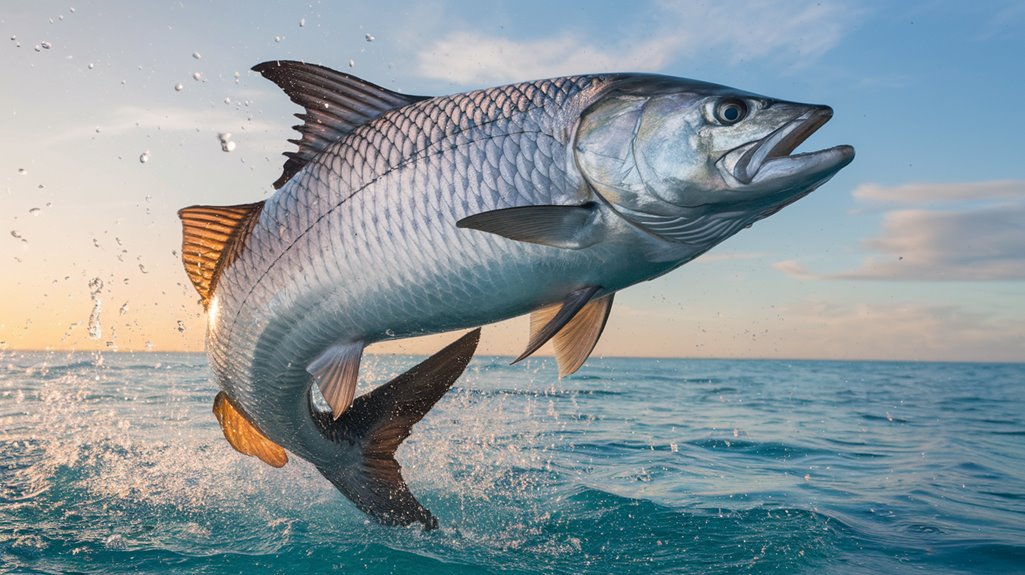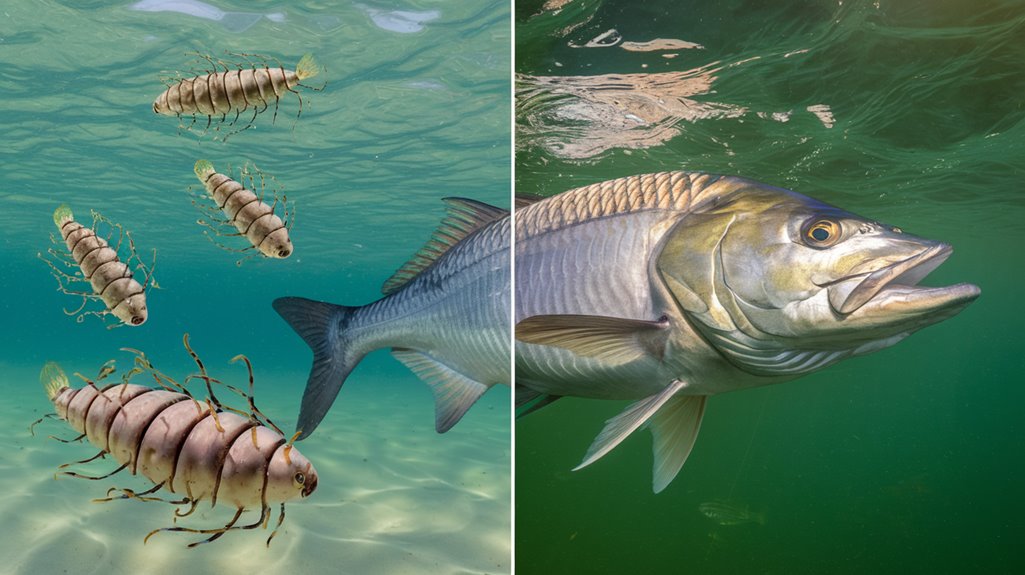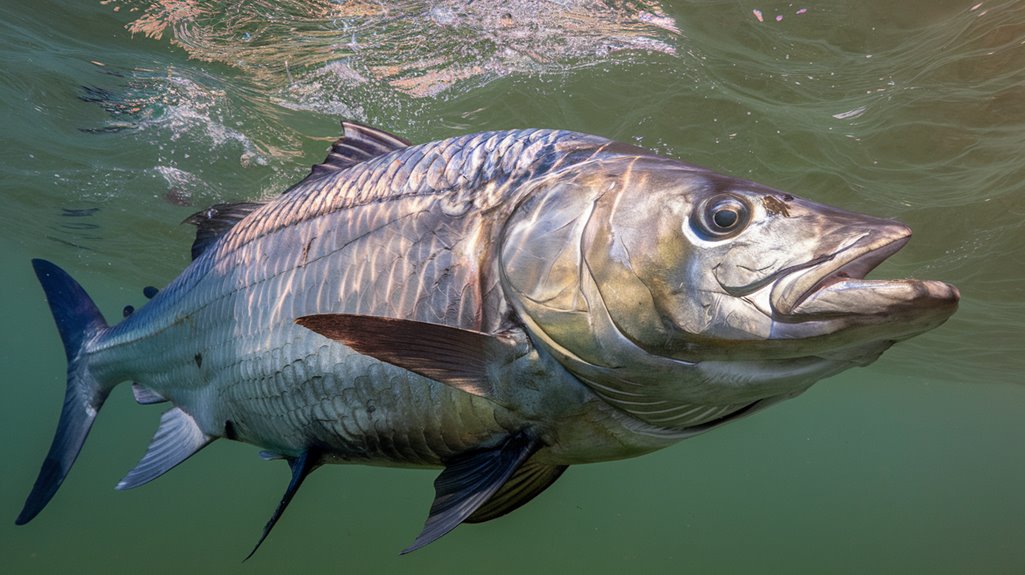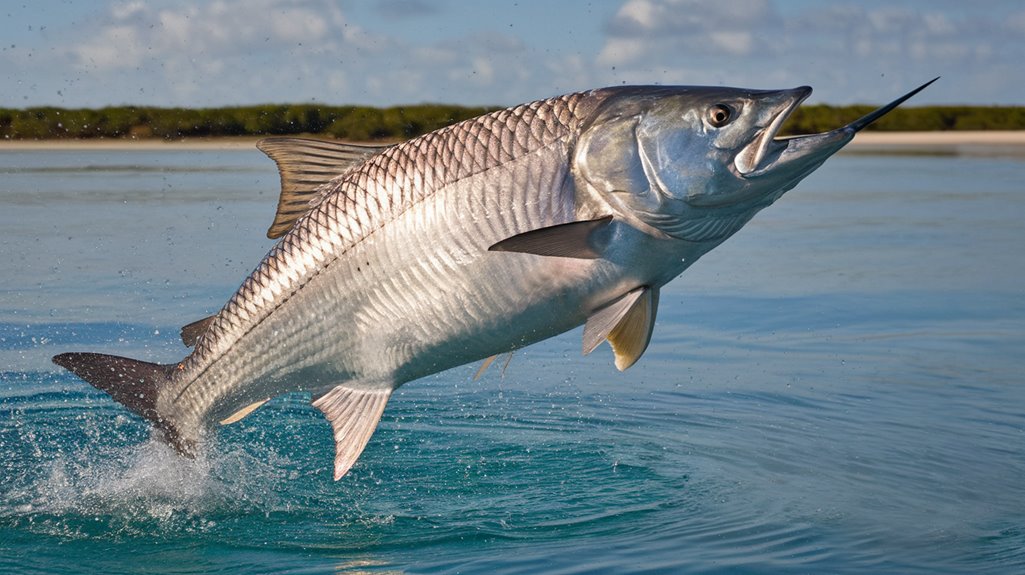You'll find tarpon to be among the most resilient and long-lived fish species in our oceans. These remarkable creatures can survive for over half a century in the wild, with some specimens pushing past 80 years of age. While their impressive lifespan is well-documented, the factors that contribute to their longevity remain complex and interrelated. Understanding how these ancient fish achieve such extraordinary lifespans holds valuable insights for marine science and conservation.
- Key Takeaways
- Understanding the Tarpon's Natural Life Cycle
- Factors Affecting Tarpon Longevity
- Growth Patterns From Larvae to Adult
- Male vs. Female Tarpon Life Expectancy
- Record-Breaking Age Observations
- Survival Challenges Throughout Different Life Stages
- Conservation Impact on Tarpon Lifespan
- Frequently Asked Questions
- Conclusion
Key Takeaways
- Tarpon typically live between 30-50 years in the wild, with some documented cases reaching up to 80 years.
- Female tarpon generally outlive males, with females living beyond 50 years while males typically max out at 30 years.
- The oldest recorded captive tarpon lived to 63 years at Chicago's John G. Shedd Aquarium.
- Scientists verify tarpon age through otolith analysis, examining growth rings in fish ear bones like counting tree rings.
- Environmental factors, fishing pressure, and habitat quality significantly influence tarpon lifespan and survival rates.
Understanding the Tarpon's Natural Life Cycle

While tarpon may appear resilient and adaptable, their life cycle follows a precise sequence of developmental stages that determines their long-term survival. The journey begins during spawning season from April to July, when females release up to 12 million eggs. You'll find that the larval stage is particularly critical, as newly hatched transparent leptocephalus must survive their first month before migrating to estuarine habitats.
Sexual maturity takes 6-13 years, with females developing later than males. Once mature, tarpon can live 30-50 years in the wild, with females typically outliving males. Throughout their life cycle, these fish require specific habitat conditions, particularly in their juvenile stage, when they need low-oxygen environments in backwater areas for proper development and survival.
Factors Affecting Tarpon Longevity
You'll find that a tarpon's survival depends heavily on environmental conditions, including water quality, temperature fluctuations, and habitat availability. Natural predators, particularly during juvenile stages, and diseases can greatly reduce tarpon populations and affect their potential to reach their full lifespan of 50+ years. These mortality factors become more pronounced when combined with human-induced stressors such as habitat degradation and fishing pressure, making it essential to understand their cumulative impact on tarpon longevity.
Environmental Impact On Survival
Despite their remarkable potential to live beyond 80 years, tarpons face numerous environmental challenges that greatly impact their survival rates and longevity. Water quality degradation and habitat loss substantially affect these fish throughout their lifecycle, with juvenile tarpon being particularly vulnerable in estuarine environments.
You'll find these essential environmental factors affecting tarpon survival:
- Sudden temperature drops causing mass mortality events
- Reduced dissolved oxygen levels in juvenile habitats limiting survival rates
- Increased predation pressure from sharks and birds due to habitat disruption
- Chronic stress from pollution and overfishing affecting reproductive success
These environmental pressures continue to threaten tarpon populations, making conservation efforts vital for maintaining their natural longevity potential and ensuring the species' long-term survival in affected ecosystems.
Natural Predation And Disease
Natural predation and disease represent significant mortality factors that influence tarpon longevity throughout their life stages. You'll find that large sharks, particularly bull and hammerhead species, pose a constant threat to adult tarpon, while juvenile tarpon face intense predation from piscivorous birds in their nursery habitats. Disease presents another vital challenge, with internal parasites like Lecithochirium microstomum weakening these fish and compromising their survival rates.
The combination of environmental factors, including habitat loss and degraded water quality, creates additional stressors that can trigger disease outbreaks in tarpon populations. These natural threats are further amplified by human activities, such as overfishing and improper catch-and-release practices, which can reduce their chances of reaching full life expectancy. Understanding these mortality factors is essential for implementing effective conservation strategies to protect tarpon populations.
Growth Patterns From Larvae to Adult

Throughout their remarkable lifecycle, tarpons undergo distinct developmental stages that transform them from tiny leptocephali larvae to impressive adult specimens. During the one-month larval stage, you'll find these fish growing from minuscule sizes to 3-4 inches, resembling small eels.
The growth pattern follows this progression:
- Leptocephali larvae develop in offshore waters for approximately 30 days
- Juvenile tarpon migrate to backbay creeks, using their swim bladder to survive low-oxygen conditions
- Sub-adults expand their diet and habitat use over 2+ years
- Adult tarpon reach sexual maturity at different ages (females ~10 years, males 4-5 years)
You'll observe that these fish can achieve impressive life spans of 80+ years, with females growing to 4.5 feet and males to 4 feet, as they migrate long distances for spawning.
Male vs. Female Tarpon Life Expectancy
While both sexes demonstrate remarkable longevity among fish species, female tarpons greatly outlive their male counterparts by approximately 20 years. You'll find that female tarpon can reach an impressive 50+ years, with the oldest captive specimen living to 63 years. Males typically max out at around 30 years. Sexual maturity also varies notably between genders, affecting their population dynamics.
| Characteristic | Male vs Female Comparison |
|---|---|
| Lifespan | Males: 30 years / Females: 50+ years |
| Sexual Maturity | Males: 6-7 years / Females: 10 years |
| Growth Rate | Males: Lower / Females: Higher |
| Size Potential | Males: Smaller / Females: Larger |
| Habitat Needs | Both require protected spawning areas |
These biological differences underscore why you'll need to evaluate gender-specific factors when implementing conservation strategies to protect tarpon habitats and maintain healthy populations.
Record-Breaking Age Observations

You'll find the most remarkable tarpon age record in captivity at Chicago's John G. Shedd Aquarium, where a specimen lived to 63 years, though wild specimens have been documented to reach 80 years. Scientists verify tarpon ages through otolith analysis and growth ring examination, similar to counting tree rings, which allows differentiation between wild and captive specimens. The disparity between wild and captive longevity records demonstrates environmental factors' significant impact on tarpon lifespan, with wild specimens typically achieving greater ages due to natural habitat conditions.
Oldest Documented Tarpon Cases
Several remarkable cases highlight the extraordinary longevity potential of tarpons, with the most notable record belonging to a captive specimen that reached 63 years of age. You'll find significant differences between the sexes, as females can exceed 50 years while males typically live up to 30 years.
Research documents these impressive age milestones:
- Females reaching sexual maturity between 6-13 years
- Large tarpon achieving 100-pound weights by ages 13-16
- Mature females producing up to 12 million eggs at 6.6 feet length
- The oldest tarpon in captivity surviving to 63 years
Lifespan data demonstrates that these fish have evolved to sustain long life cycles, supporting their role as one of the ocean's most enduring species. Their extended maturation period indicates an evolutionary adaptation for long-term survival.
Wild Vs Captive Longevity
Despite sharing genetic potential for longevity, wild and captive tarpons exhibit distinct age patterns that reveal fascinating insights into their life expectancy. You'll find that wild male tarpons typically reach 30 years, while females demonstrate remarkable resilience, living beyond 50 years. In captive environments, where they're sheltered from fishing pressures and adverse environmental factors, tarpons can achieve even greater longevity, with the record holder reaching 63 years. This significant disparity between wild and captive lifespan highlights the impact of controlled conditions on tarpon survival. While wild populations maintain an impressive average lifespan of 55 years, you'll notice that females, which can grow to over 8 feet and 300 pounds, consistently outlive their male counterparts in both settings.
Age Verification Methods
Determining a tarpon's exact age requires sophisticated scientific methods that provide concrete evidence of their longevity records. Through otolith analysis, you'll find that researchers examine growth rings in the fish's ear bones, similar to counting tree rings. This precise age verification technique has helped establish remarkable life span benchmarks:
- Female tarpons can reach 50+ years old in the wild
- Male specimens typically live up to 30 years
- Captive specimens have reached 63 years
- 4-foot specimens average 13-16 years old
Tagging studies complement these findings by tracking tarpon movements up to 1,200 miles, providing additional data on growth patterns and age-related behaviors. This thorough approach to age verification guarantees accurate documentation of tarpon longevity across different environments and life stages.
Survival Challenges Throughout Different Life Stages
Throughout their lifespan, tarpons encounter distinct survival challenges that vary considerably with each developmental stage. As larvae, they face intense predation from zooplankton and small fishes, drastically reducing survival rates during their first month. You'll find juvenile tarpon seeking refuge in backwater estuaries, where low oxygen levels deter predators, though they still require specific protective habitats. Sub-adults must compete intensively for food and space as they develop. Adult tarpon, despite their potential 80-year lifespan, struggle against habitat loss and overfishing pressures. Their slow path to sexual maturity, taking 6-13 years, makes them particularly vulnerable to environmental changes. These factors create a complex web of challenges that impact population sustainability throughout their different life stages.
Conservation Impact on Tarpon Lifespan
Conservation efforts have emerged as a critical factor in preserving the remarkable 80-year lifespan potential of tarpons. You'll find that habitat loss and overfishing greatly threaten their longevity, as evidenced by population declines in areas like Port Aransas, Texas. Conservation measures, particularly in Florida where commercial sales are prohibited, have become essential for protecting tarpon lifespan and ensuring population stability.
Key conservation strategies that support tarpon survival include:
- Implementation of catch-and-release practices to reduce fishing mortality
- Protection of critical habitats along migration routes
- Research initiatives tracking tarpon migration patterns
- Restoration of degraded nursery and feeding grounds
Understanding these fish's complex life cycles and habitat requirements continues to shape effective conservation approaches, directly impacting their ability to reach their full lifespan potential.
Frequently Asked Questions
How Old Is a 100 Pound Tarpon?
You'll find that a 100-pound tarpon typically ranges between 13 to 16 years old, reflecting their relatively slow growth rate compared to other fish species of similar size.
Are Tarpon Fish Aggressive?
You'll find that tarpon aren't aggressive fish. While they exhibit powerful, erratic movements when hooked, their behavior is defensive rather than hostile. They're opportunistic feeders, not confrontational predators.
What Are Baby Tarpons Called?
You'll find that baby tarpons are called leptocephali – transparent, ribbon-like larvae that look like small eels. They'll remain in this form for about one month, growing to 3-4 inches long.
What Is the Oldest Tarpon in Captivity?
You'll find that the oldest documented tarpon in captivity reached 63 years of age, demonstrating these fish's remarkable longevity potential when kept in controlled environments away from natural threats.
Conclusion
You'll find that tarpon's remarkable longevity sets them apart in marine ecosystems, with females reaching 50+ years and males averaging 30 years. You must consider how environmental factors, including water quality and habitat preservation, directly influence their lifespan potential. When you examine survival rates across life stages, you'll note that anthropogenic impacts greatly affect whether these fish achieve their maximum life expectancy of 80 years.

